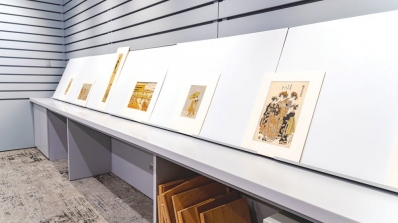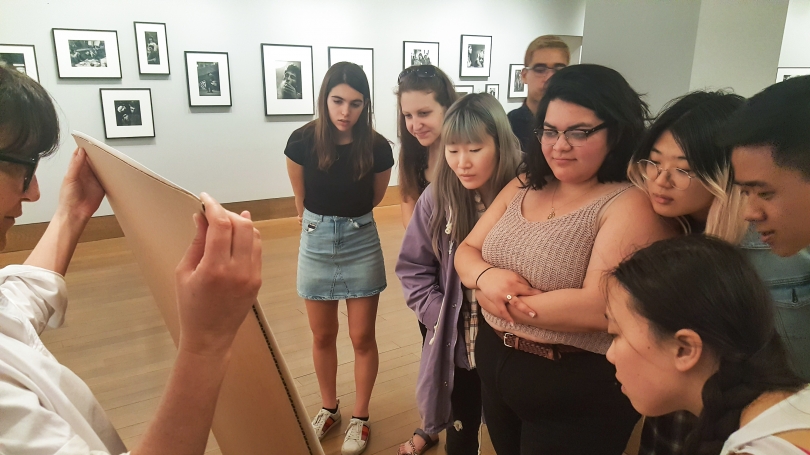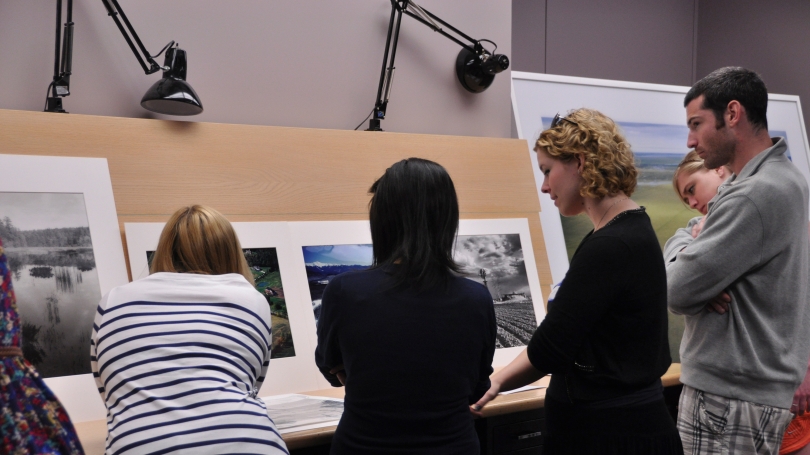Museum Collecting 101
EACH YEAR, DARTMOUTH STUDENTS SELECT WORKS TO ENTER THE MUSEUM'S PERMANENT COLLECTION.
Through Museum Collecting 101, a non-curricular course offered during either winter or spring terms, Dartmouth students from all backgrounds and majors take part in an exciting and important aspect of the museum: acquisitions. For several weeks, a group of up to twelve students meets weekly with curatorial and education staff in two-hour sessions to learn about the museum's collections and acquisitions process. Students are introduced to a selection of artists and their work, which they discuss in depth, especially in terms of the potential for interdisciplinary curricular connections. Students choose an artist, consider several potential purchases, and vote to select one work. Past participants have sometimes had the opportunity to travel to New York or Boston to visit art dealers and examine the works in person.
Applications for Museum Collecting 101 will open on Monday, March 31, 2025, and will not be accepted before that date.
THE PROGRAM: The opportunity to meet with the Hood Museum's director and curators and be introduced to the museum's collection. You'll discuss the criteria curators use to acquire works of art for a museum collection and review the work of several artists. You'll travel to New York to view works in person at dealers. Finally, you'll select a work of art for the Hood Museum to add to its collection.
WHEN:
Time: Monday afternoons, 3:30–5:00 pm
Dates: April 21, April 28, May 5, May 10-11, and May 12
Field Trip to New York: May 10-11, 2025
WHERE: Meeting in-person in the Bernstein Center for Object Study at the Hood Museum of Art.
THE TYPE OF ART: This year's theme is Art Meets Science. This year's program focuses on how artworks contribute to, complement, and complicate our understanding of scientific processes. Since the 15th century prints have been essential in circulating new knowledge about plants, the body, chemistry, or astronomy. These works chronicled new discoveries or served in the classroom across centuries. We will examine a range of works that demonstrate how artists translated knowledge and made it available to the broader public. You will work closely with the Hood's Andrew W. Mellon Curator of Academic Programming and Curator of European Art, Elizabeth Rice Mattison.
TRIP TO NEW YORK CITY: The class will leave Hanover early on Saturday, May 10, and return Sunday, May 11. While in New York the class will visit art dealers among other activities. Attending the trip is required for participation in the program.
Transportation, accommodations, and a meal stipend will be covered by the museum.
TO SIGN UP:
Participation is limited to Dartmouth students. FREE. No previous art knowledge or experience necessary. All classes and majors welcome.
Applications for Museum Collecting 101 are open on Monday, March 31, 2025, and will not be accepted before that date.
To apply, write Look.at.the.Hood@dartmouth.edu and tell us your name, year, major, and briefly why you would like to participate.
Applications are accepted on a rolling basis.
Space is limited and participation in all five sessions is required. Priority will be given to students who have not previously participated in a Museum Collecting 101 program.
QUESTIONS:
Please contact Look.at.the.Hood@dartmouth.edu
Museum Collecting 101 Mission
Museum Collecting 101 has been dedicated mainly to strengthening the Hood Museum of Art's contemporary photography collection. Since the program was founded in 2002, the Hood Museum has acquired photographs from a wide range of artists, representing various subjects. Each year, Hood staff determine a specific area of contemporary photography for students to focus on, such as Latin American photography, female photographers, landscape photography, digitally altered works, Asian photography, and documentary photography. Occasoinally, as in 2025, the program has shifted to the museum's print collection.
Selected Artists
Artists whose work students have selected for the museum to purchase include:
- Nobuyoshi Araki
- Daniel Beltra
- Jules de Bruycker
- Tseng Kwong Chi
- J Henry Fair
- Christina Fernandez
- Tierney Gearon
- Maïmouna Guerresi
- Miskha Henner
- Mika Horie
- James Karales
- Atta Kim
- O. Winston Link
- Loretta Lux
- Aida Muluneh
- Mario Cravo Neto
- Zanele Muholi
- Daniela Rossell
- Sebastião Salgado
Leaving a Legacy
Museum Collecting 101 is a rich and vibrant program that has allowed undergraduate students to leave a legacy that extends far beyond their four years on campus. The names of all of the students who participate in the program are included in the credit line for the work of art they selected for purchase, and the works they have chosen are frequently used for teaching and exhibitions.





